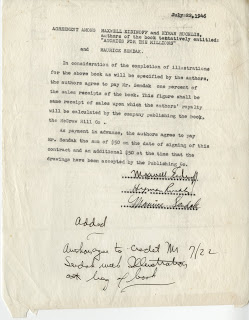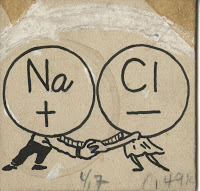 |
| Final drawing for Atomics for the Millions. Pen and ink, gouache. (C) 1946-7 by Maurice Sendak. |
Maurice Sendak got his first “gig”
in the world of book illustration when he was 18, as some astonishing materials
recently purchased by the Rosenbach attest.
It was the spring of 1946, and his physics teacher at Lafayette High
School in Brooklyn, Hyman Ruchlis—recalling Sendak’s artistic talent from his
contributions to the school literary magazine and comic strips—asked his
student to produce illustrations for a book he was co-writing on atomic
energy. Ruchlis, co-author
Maxwell Eidinoff, and publisher McGraw Hill, needed lively and informative
scientific diagrams as well as larger pictorial sequences for their book,
tentatively titled Atomic Adventures. This week the Rosenbach acquired 18 original
drawings for Atomics for the Millions,
as it came to be called, as well as the contracts signed by Sendak and the
authors.
 |
| Contract for Atomics for the Millions, July 22, 1946 |
It wasn’t a bad “gig” for an
18-year-old aspiring artist. As the
contract shows, Sendak was paid $100: $50 in advance, $50 upon delivery (though,
as legend has it, a passing grade in physics was also part of the deal). It was hard-earned, since Sendak created over
100 pen-and-ink illustrations for the book, with imagery as diverse as a
portrait of Einstein contemplating the relationship between matter and energy, the
uncontrolled atomic reaction triggered by a nuclear weapon, and a medieval
alchemist in his rudimentary laboratory.
A dome-headed, lab-coated scientist also shows up in several of Sendak’s
drawings investigating the secrets of the atom.
He has the feel of a stock comic book scientist, possibly of the “mad”
variety.
Sendak illustrated another book: Marcel Ayme’s Wonderful Farm, which marked the beginning of his career in
children’s books. Sendak’s illustrations for Atomics for the Millions were long
presumed destroyed, and it is a shame no other illustrations have
resurfaced. But these 18 demonstrate a number
of characteristics about the young illustrator that could be said of the mature Sendak, as well. They reveal his debt to comics and early animation; his blend of literal, serious imagery (such as the Einstein and Curie portraits) with imaginative, humorous illustrations (Sodium and Chlorine atoms as dancing partners “attracted” to each other); and his developing pen-and-ink style that favored shading and texture through cross-hatching. Atomics for the Millions might not be the brightest star in the constellation of Sendak-illustrated books, but it may just be the big bang where some of the elements of his illustration find their origins. See for yourself next week, when we install one or two of the drawings in our current exhibition, Maurice Sendak: A Legacy (closes May 26th).

